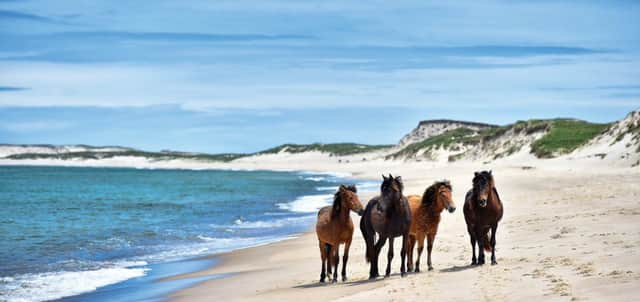Canada: The Wild Horses of Sable Island


Since shipwrecks were recorded in 1530, there have been 350 off Sable Island, the last in the 1940s. Today, modern navigation systems enable safe passage through this often foggy, sandbar-ridden part of the Atlantic Ocean. Even so, not many people know about or land on Sable Island.
Described as being as wide as a sprint and as long as a marathon, the island 250 kilometres southeast of the Canadian city of Halifax measures 26 miles long and one mile across. The only four-legged mammals living on it are 550 feral horses, a breed that has survived on the island for 250 years without human interference. It is believed that the horses wandering the dunes today are most likely descendants of ones seized by the British from the Acadians during their expulsion from Nova Scotia in the 1750s and 1760s. During attempts to colonise or farm Sable Island, the horses were introduced along with chickens, cows, sheep and goats, but were the only animals to survive. Later, when a life-saving station was set up to help sailors get to shore, Bostonian shipowner and merchant Thomas Hancock shipped 60 horses to Sable Island, where they bred with the original equines.
Advertisement
Hide AdEach year, expedition specialist Adventure Canada brings travellers to Sable Island by ship to see the island’s unique wildlife, and so it was that after a two-day journey we dropped anchor a couple of miles off the shoreline. Visitors can’t stay on the island so we spent three days sleeping and eating on the ship, making daily visits by Zodiac rigid inflatable boats.
Sable Island was established as a Canadian national park in 2013 and just a handful of researchers and Parks Canada staff are allowed to stay a few months at a time there. Jonathan Sheppard, Sable Island park manager, said: “Parks Canada considers the Sable Island horses to be a wild population. They are wildlife. Parks Canada understands the horses are part of the ecological system on the island now.”
About 300 people a year visit the island and Parks Canada is not encouraging many more. “We are currently doing a lot of fact finding to assess the feasibility of various visits,” said Sheppard. “We know that Sable Island remains a very remote place and it always will. This place is unpredictable; the weather and geography make it expensive to get to.”
Sable Island is not without controversy. Back in 1960, the Canadian Federal Government ordered that the horses be removed from the island because they were damaging the fragile environment. There was a public outcry, with schoolchildren writing letters to the Canadian prime minister imploring him to save the horses. The horses stayed and a law was passed that made it illegal to interact with them.
We crossed a choppy swell to reach the island a mile away, surfing the Zodiacs on to the north beach; this is the most interesting part of the island, with the 30-foot Bald Dune dominating the landscape. A heavy fog had swept across the island and I could just make out the ghostly shapes of horses moving through the sand dunes that line the long stretch of pristine beach that goes on for miles. A spine of dunes also runs north to south through the middle of the island which is also home to the world’s largest grey seal colony and various rare birds.
There are around 40 to 50 small herds, each consisting of a stallion, a few mares and their young, and we were told to keep a distance of 20 metres away and not to feed them.
Advertisement
Hide AdWandering the Bald Dune area and on to the south beach, we saw evidence of the horses’ life-cycle, from newly born foals to carcasses in the sand. With shaggy coats, wild manes and tails that touch the ground, the horses have adapted to the island’s conditions. Unfortunately, excessive inbreeding, extreme weather, lack of food and potential global warming threaten their existence. And with the average lifespan short at between five and ten years, some question why the horses are left there.
It’s truly amazing that they survive here at all. They have learned to dig in the sand with their hooves until pools of fresh water appear and brackish freshwater holes dot the island, some the size of a small lake.
Advertisement
Hide AdAs we walked on, following narrow tracks made by the horses and avoiding any nesting birds or delicate fauna, behind every dune large or small, horses would appear. At times a small herd of maybe six, sometimes a lone animal, all of them accustomed to researchers and unfazed by our presence. For this is their island, and for the moment they have won the struggle to survive against the odds. But who knows what the future holds for the horses of Sable Island?